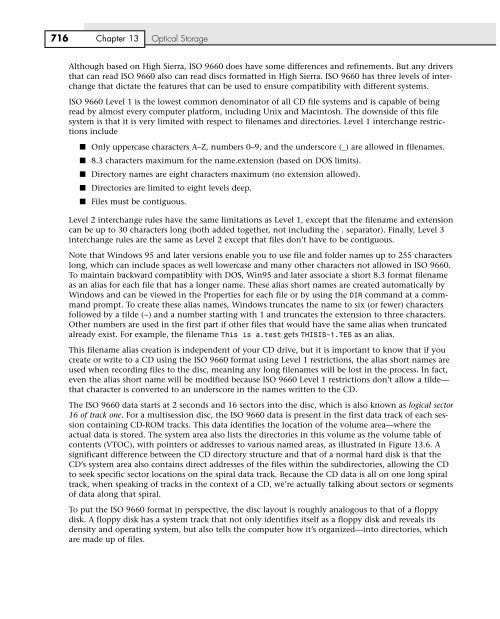You also want an ePaper? Increase the reach of your titles
YUMPU automatically turns print PDFs into web optimized ePapers that Google loves.
716 Chapter <strong>13</strong> Optical Storage<br />
Although based on High Sierra, ISO 9660 does have some differences and refinements. But any drivers<br />
that can read ISO 9660 also can read discs formatted in High Sierra. ISO 9660 has three levels of interchange<br />
that dictate the features that can be used to ensure compatibility with different systems.<br />
ISO 9660 Level 1 is the lowest common denominator of all CD file systems and is capable of being<br />
read by almost every computer platform, including Unix and Macintosh. The downside of this file<br />
system is that it is very limited with respect to filenames and directories. Level 1 interchange restrictions<br />
include<br />
■ Only uppercase characters A–Z, numbers 0–9, and the underscore (_) are allowed in filenames.<br />
■ 8.3 characters maximum for the name.extension (based on DOS limits).<br />
■ Directory names are eight characters maximum (no extension allowed).<br />
■ Directories are limited to eight levels deep.<br />
■ Files must be contiguous.<br />
Level 2 interchange rules have the same limitations as Level 1, except that the filename and extension<br />
can be up to 30 characters long (both added together, not including the . separator). Finally, Level 3<br />
interchange rules are the same as Level 2 except that files don’t have to be contiguous.<br />
Note that Windows 95 and later versions enable you to use file and folder names up to 255 characters<br />
long, which can include spaces as well lowercase and many other characters not allowed in ISO 9660.<br />
To maintain backward compatiblity with DOS, Win95 and later associate a short 8.3 format filename<br />
as an alias for each file that has a longer name. These alias short names are created automatically by<br />
Windows and can be viewed in the Properties for each file or by using the DIR command at a commmand<br />
prompt. To create these alias names, Windows truncates the name to six (or fewer) characters<br />
followed by a tilde (~) and a number starting with 1 and truncates the extension to three characters.<br />
Other numbers are used in the first part if other files that would have the same alias when truncated<br />
already exist. For example, the filename This is a.test gets THISIS~1.TES as an alias.<br />
This filename alias creation is independent of your CD drive, but it is important to know that if you<br />
create or write to a CD using the ISO 9660 format using Level 1 restrictions, the alias short names are<br />
used when recording files to the disc, meaning any long filenames will be lost in the process. In fact,<br />
even the alias short name will be modified because ISO 9660 Level 1 restrictions don’t allow a tilde—<br />
that character is converted to an underscore in the names written to the CD.<br />
The ISO 9660 data starts at 2 seconds and 16 sectors into the disc, which is also known as logical sector<br />
16 of track one. For a multisession disc, the ISO 9660 data is present in the first data track of each session<br />
containing CD-ROM tracks. This data identifies the location of the volume area—where the<br />
actual data is stored. The system area also lists the directories in this volume as the volume table of<br />
contents (VTOC), with pointers or addresses to various named areas, as illustrated in Figure <strong>13</strong>.6. A<br />
significant difference between the CD directory structure and that of a normal hard disk is that the<br />
CD’s system area also contains direct addresses of the files within the subdirectories, allowing the CD<br />
to seek specific sector locations on the spiral data track. Because the CD data is all on one long spiral<br />
track, when speaking of tracks in the context of a CD, we’re actually talking about sectors or segments<br />
of data along that spiral.<br />
To put the ISO 9660 format in perspective, the disc layout is roughly analogous to that of a floppy<br />
disk. A floppy disk has a system track that not only identifies itself as a floppy disk and reveals its<br />
density and operating system, but also tells the computer how it’s organized—into directories, which<br />
are made up of files.
















